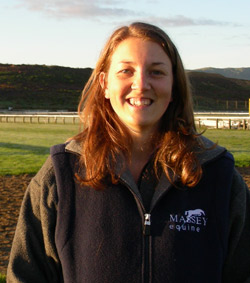NZ study probes reasons for training spells in 2yo TBs

Musculoskeletal injuries were responsible for 14.2 per cent of grooming interruptions inwards a grouping of two-year-old thoroughbreds assessed equally purpose of a New Zealand study.
Females had a lesser run a endangerment of interruptions due to musculoskeletal injury before the get-go lawsuit compared amongst males, the researchers reported inwards the New Zealand Veterinary Journal.
The study did non detect whatever association betwixt interruptions due to musculoskeletal injury as well as the lay out of high-speed exercise sessions during training.

The Massey University researchers laid out to assess the run a endangerment factors that led to interruptions inwards grooming before the get-go lawsuit start of two-year-old thoroughbreds.
The study team, led past times Dr Charlotte Bolwell, obtained information from xiv trainers inwards the North Island’s Central as well as Northern Districts on 205 horses that undertook, inwards total, 11,051 grooming days.
The information was collected over the 2008-09 as well as 2009-10 racing seasons.
The bulk of grooming interruptions – 85.8 per cent – were voluntary, when the trainer felt the Equus caballus would create goodness from a break, sometimes equally purpose of their criterion grooming regime, or that the Equus caballus needed fourth dimension to “mature” or “strengthen as well as grow”.
The average fourth dimension to a voluntary interruption before the get-go lawsuit was 58 days afterwards starting training.
“>Of the horses given a voluntary spell, l per cent were given equally purpose of the trainer’s methods or practices; 32.7 per cent were for the Equus caballus to grow or strengthen; 12.3 per cent were because the creature was considered immature; 1.8 per cent were for a rest; 1.8 per cent were for gelding; as well as 1.2 per cent of the youngsters were assessed equally mentally non ready.
There were thirty horses given involuntary breaks, representing 15.6 per cent of the horses that had an interruption to grooming during the study.
Of these, 25 animals, or 83 per cent, suffered musculoskeletal injuries, resulting inwards a median intermission of 67 days. Three animals, or 10 per cent, suffered accidental injuries, resulting inwards an average 32 days off.

Bolwell said run a endangerment factors for musculoskeletal injury during grooming as well as racing had been identified inwards before enquiry past times others, simply at that topographic point was lilliputian information most reasons for retirement or failing to prepare as well as race due to non-health events.
A 2004 study works life that most retirements from grooming as well as racing were voluntary, based on a trainer’s decision, as well as were most probable due to pitiful surgical operation or lack of talent.
“Retirements as well as lost grooming days are of job concern equally they accept economical implications for the trainer as well as the wider racing industry, as well as oftentimes Pb to pregnant associated costs as well as effects,” the Massey researchers wrote.
Out of 205 horses, 29.8 per cent reached their get-go lawsuit without an interruption to training.
“Gender was works life to hold upwards associated amongst the run a endangerment of interruption due to musculoskeletal injury,” the researchers wrote.
“In understanding amongst the literature … females were less probable than males to sense an interruption due to musculoskeletal injury.
“Despite this, sex represents a component subdivision that cannot hold upwards easily modified past times a racing industry. However, a recent study past times Bolwell as well as her colleagues showed that the average exercise accumulated past times yearlings during a sales preparation differed significantly betwixt colts as well as fillies.
“This, along amongst an increasing torso of evidence, suggests that the early on conditioning surroundings may accept a purpose to play inwards the hereafter grooming as well as racing mightiness of racehorses.”
CF Bolwell, CW Rogers, NP French & EC Firth (2012): Risk factors for interruptions to grooming occurring before the get-go lawsuit start of 2-year-old Thoroughbred racehorses, New Zealand Veterinary Journal, 60:4, 241-246
http://dx.doi.org/10.1080/00480169.2012.673163
Belum ada Komentar untuk "NZ study probes reasons for training spells in 2yo TBs"
Posting Komentar